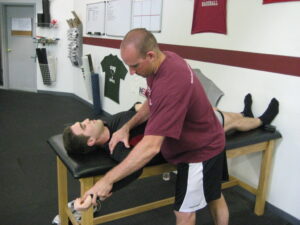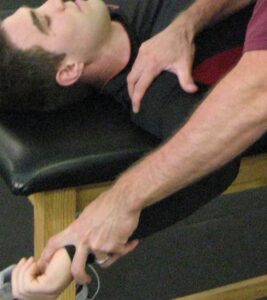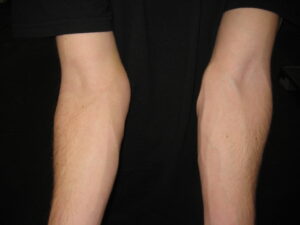Shoulder Mobility Drills: How to Improve External Rotation (if you even need it)
Last summer, a college pitcher came up to Cressey Performance from the South to train for a month before his summer league got underway. He was seven months post-op on a shoulder surgery (Type 2 SLAP) and had been working his way back. Unfortunately, his arm was still bothering him a bit when he got up to see us.
After the first few days at CP, though, he told me that his arm felt as good as it’s felt in as long as he could remember. He’d been doing a comprehensive strength and conditioning program, but the “impact” stuff for him had been soft tissue work, some Postural Restoration Institute drills, an emphasis on thoracic mobility, and manual stretching into internal rotation, horizontal adduction, and shoulder flexion. From all the rehab, his cuff was strong and scapular stabilizers were functioning reasonably well – which led me to believe that his issues were largely due to tissue shortness and/or stiffness.
This realization made me immediately wonder what he’d been doing in the previous months for mobility work for his arm – so I asked. He then demonstrated the manual stretching series that every pitcher on his team went through every day on the table with their athletic trainer. Each stretch was done for 2x20s – and two of those stretches took him into extreme external rotation and horizontal abduction. I was pretty shocked.
Me: “You’re probably not the only guy on your team rehabbing right now, huh?”
Him: “No; there are actually too many to count.”
Me: “Elbows, too, I’m sure.”
Him: “Yep.”
Want to irritate a labrum, biceps tendon, or the undersurface of the rotator cuff? Stretch a thrower into extreme external rotation and simulate the peel-back mechanism. This also increases anterior capsular laxity and likely exacerbates the internal impingement mechanism over the long-term. To reiterate, this is a bad stretch!
Want to make an acromioclavicular joint unhappy? Stretch a thrower into horizontal abduction like this (again, this is a BAD stretch that is pictured):
Want to irritate an ulnar nerve or contribute to the rupture of an ulnar collateral ligament? Make sure to apply direct pressure to the forearm during these dangerous stretches to create some valgus stress. This is a sure-fire way to make a bad stretch even worse:
These stretches are very rarely indicated in a healthy population – especially pitchers who already have a tendency toward increased external rotation. The shoulder is a delicate joint that can’t just be manhandled – and when you’re dealing with shoulders that are usually also pretty loose (both from congenital and acquired factors), you’re waiting for a problem when you include such stretches. In fact, I devoted an entire article to this: The Right Way to Stretch the Pecs.
Everyone thinks that shoulder external rotation and horizontal abduction alone account for the lay-back in the extreme cocking position.
In reality, though, this position is derived from a bunch of factors:
1. Shoulder External Rotation Range-of-Motion – and this is the kind of freaky external rotation you’ll commonly see thanks to retroversion and anterior laxity:
2. Scapular Retraction/Posterior Tilt
3. Thoracic Spine Extension/Rotation
4. Valgus Carrying Angle
So, how do you improve lay-back without risking damage to the shoulder and elbow?
1. Soft tissue work on Pec minor/major and subscapularis – Ideally, this would be performed by a qualified manual therapist – especially since you’re not going to be able to get to subscapularis yourself. However, you can use this technique to attack the pecs:
2. Exercises to improve scapular retraction/depression/posterior tilt – This could include any of a number of horizontal pulling exercises or specific lower trap/serratus anterior exercises like the forearm wall slide with band.
3. Incorporate specific thoracic spine mobility drills – In most pitchers, you want to be careful about including thoracic spine mobility drills that also encourage a lot of glenohumeral external rotation. However, when we assess a pitcher and find that he’s really lacking in this regard, there are two drills that we use with them. The first is the side-lying extension-rotation, which is a good entry level progression because the floor actually limits external rotation range-of-motion, and it’s easy to coach. I tell athletes that they should think of thoracic spine extension/rotation driving scapular retraction/depression, which in turn drives humeral external rotation (and flexion/horizontal abduction). Usually, simply putting your hands on the shoulder girdle and guiding them through the motion is the best teaching tool.
A progression on the side-lying extension-rotation is the side-lying windmill, which requires a bit more attention to detail to ensure that the range-of-motion comes from the right place. The goal is to think of moving exclusively from the thoracic spine with an appropriate scapular retraction/posterior tilt. In other words, the arm just comes along for the ride. The eyes (and head) should follow the hand wherever it goes.
Again, these are only exercises we use with certain players who we’ve deemed deficient in external rotation. If you’re a thrower, don’t simply add these to your routine without a valid assessment from someone who is qualified to make that estimation. You could actually make the argument that this would apply to some folks in the general population who have congenital laxity as well (especially females).
4. Throw!!!!! – Pitchers gain a considerable amount of glenohumeral external rotation over the course of a competitive season simply from throwing. Sometimes, the best solution is to simply be patient. I really like long toss above all else for these folks.
In closing, there are three important things I should note:
1. You don’t want to do anything to increase valgus laxity.
2. You’re much more likely to get hurt from being “too loose” than you are from being “too tight.” When it comes to stretching the throwing shoulder, “gentle” is the name of the game – and all mobility programs should be as individualized as possible.
3. Maintaining internal rotation is a lot more important than whatever is going on with external rotation. In fact, this piece could have just as easily been named “The Two Stretches Pitchers Shouldn’t Do, Plus a Few That Only Some of Them Need.”
To learn more about testing, training, and treating throwing shoulders, check out Optimal Shoulder Performance: From Rehab to High Performance.
Sign-up Today for our FREE Baseball Newsletter and Receive a Copy of the Exact Stretches used by Cressey Performance Pitchers after they Throw!










